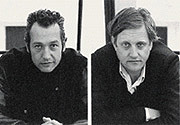| Revista Umělec 1999/1 >> Four Are More Than One | Lista de todas las ediciones | ||||||||||||
|
|||||||||||||
Four Are More Than OneRevista Umělec 1999/101.01.1999 Karel Císař | media | en cs |
|||||||||||||
|
"Although it may be hard for some to cope with it, the fact is that even in arts it becomes true that more is more. Take photography for example, henceforward one is no longer more than four. What before could be easily managed by one hand, will now require four. A unique creator is replaced with collective authorship of creative couples, a fact which seems to be more fitting for the photography medium, typical for its multiple modes of utilization. Why should an author of a piece of work, which is always a copy of the original, be unique himself/herself? Once the invention of photography enabled the birth of cinematography and today it is withdrawing the original deposit in the form of team work typical for cinematography. Is it, however, possible to trace down the character of this type of work through the resulting photographic images? And why are there so many creative pairs specifically among artists using photography since only one single hand may push the button?
The phenomenon of creative couples working with photographic imagery could on the one side be explained by certain affirmation of the camera: photography is a technical image made by the camera, not the photographer. It is not the photographer who is taking picture but his, although the adjective is not all appropriate any more, camera. By rejecting unique authorship, a couple of photographers would find themselves at the beginning of a trip whose aim is this rejection of authorship in favor of the camera - whether this would also mean that anybody might push the button or it could be done by the camera itself, had it a program with such an operation. Photography would thus admit its mass media character even in the area of so called arts. On the other hand, though, creative couples are possible to be interpreted as a certain problematization of the common understanding of pushing a button being the creative act of a photographer. The creative act would be consisting of mere photographer’s decision which is principally independent of the photographic image’s positive creation. Understood in this manner, photography would henceforward be exclusively conceptual art whether it got rid of the artifact entirely or not. One of the proofs of this interpretation’s competence include artists working on creating a photographic image with a professional photographer. To a large extent it is tenable not only in case of direct photography but also arranged photography. Unlike “hand-made“ art and, of course, manipulated photography, the author of the arranged photography is not a human being but the arranged things themselves. It is this perception of photography not as a snapshot but a contemplated decision of a kind that appears to be close to creative couples working with photographic imagery. If couple represents the cooperative author of the decision, the two have to come to such a decision through the process of discussion that is made possible by the medium of photography which merely reproduces a pre-existing phenomenon. Discussion is feasible only on such real phenomenon. The art work thus meets interpretation due to its original discoursivity. Furthermore, it is imprinted with certain concrete social configuration reflecting the two authors’ mutual relationship, be it a married couple, heterosexual or homosexual partners, friends, or siblings, including one-egg twins. Visual art abandons its modernist formula which defined it within society while admitting its social character. It takes over strategies typical for corporate structures such as the melting pot of entertainment and advertising industries, in fact its competitors. Parallel to rejecting unique authorship is not only the multiplicative character of the photographic media but also typical creation of closed series of photographic images whose context makes up the final meaning of the individual pictures. With their installation and enlargement, photographs take over the role of traditional “hand-made“ hung painting. Common to both of them is certain aspect of totality, unity which is completely missing in case of fragmentary document photography. Two different relations meet in photography: causal relation exists between a thing and its image on a technological level, the thing is the cause of its photographic image; on the semantic level, however, the image refers to intentional relation between a human being and the thing photographed which should be perceived a key guide to interpretation of photographic images. Self-reflective relation typical for self-portrait is of special interest here whether it is a self-portrait in the common sense of the word or allegorical self-portrait, such as photographs of architecture. In case of creative couple, this reflexive relation is magnified into polyphony referring to a common foundations of the world of things and the world of people which is - just like all relations - inherent in something else than interplay of parts and wholes. "
01.01.1999
Artículos recomendados
|
|||||||||||||










Comentarios
Actualmente no hay comentariosAgregar nuevo comentario